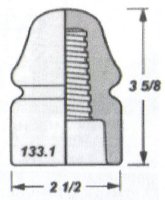Insulator Hunting Tips
Reprinted from "Crown Jewels of the Wire", April 2004, page 5
Last year I wrote a couple of stories about the good old days when insulators
were still plentiful on poles. If you were lucky, you could pick some off the
ground where the linemen left them. Some linemen would give insulators to you
just so they didn't have to take them back to the shop.
I had a lineman once who gave me a bucket full of insulators that he had taken
down that day. In the bucket were two Homer Brooke's signals. He thought I might
like them because they were a pretty blue. If he only knew! Several linemen
would save insulators for me. And once in a while, on a Friday, I would stop off
with a cold 12-pack to give them.

If you know any old linemen in your area, talk to them and ask if they threw
away the glass and porcelain insulators, and where. I found a dump out at
Newark, Ohio by asking the linemen on the railroad where they threw the glass.
Trust me, I helped tear down old lines a few times. The glass gets heavy real
fast. That's why the linemen would look for a steam, or drainage ditch, or even a
cave to hide the insulators.
I have talked to many old telephone and power workers, and they told me they
hid insulators all over (the hills in Southern Ohio, West Virginia and Kentucky.
So you know workers did the same all over the country. Linemen were only
concerned about the copper wire and thought nothing of the insulators.
In a couple of years when I retire, again, I am going to spend a lot of time
in the hills looking for hidden caches of insulators. I have been checking some
abstracts of the land in Ohio where I used to live. The route of a railroad was
changed in 1870 there. If I can find just one old pole stump, I'll be able to
measure out to find the next one. Maybe the pole will be gone and the hole
filled up with threadless glass! I just know there remains a lot of glass out
there if someone wants to research the lines they might have a chance at finding
it.
Ed Hollar, the Old Polecat
Editor's Note: Insulators embossed with the name Homer Brooke's are found in
a distinctive color affectionately called by collectors, "Brooke's
blue". Brooke's insulators in that color are the CD 133.1 signals Ed
described above, as well as the CD 120 style. The diagram shown on this page is
from "Insulators Price Guide" by John and Carol McDougald. The Price
Guide is the most important reference book on North American Glass Pin type
Insulators.
| 